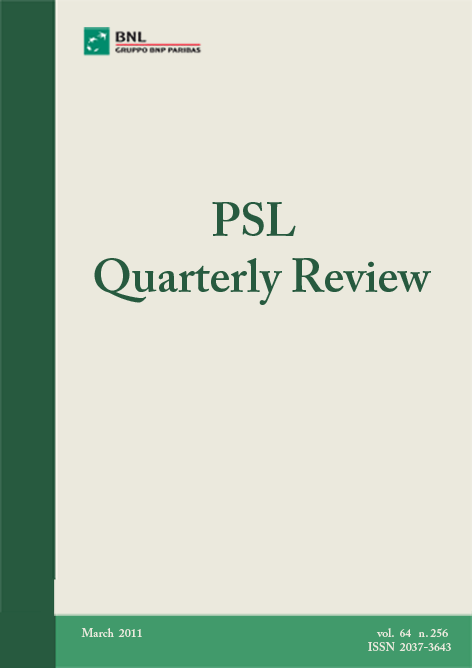Financialization in the Light of Keynesian Theory
DOI:
https://doi.org/10.13133/2037-3643/9419Keywords:
financialization, Keynes, Minsky, Kaldor, aggregate demand, capital gains.Abstract
Episodes of financial crises are usually recognizable as belonging to a general pattern despite their different historical specificities. The present essay attempts to isolate and understand the recurring common features of several recent crises in advanced market economies in the light of Keynesian theory with some crucial modifications introduced later, particularly by Kaldor and Minsky with respect to the financial sector. While financial innovations are devised continuously to escape regulations on the formal credit system by creating substitutes for bank credit, fragility increases along with the internal illiquidity of the financial system. The proclivity of the system to financial crisis arising from negative shocks can be understood against the background of systemic illiquidity coupled with rapid expansion of a range of credit substitutes in a network of tightly interlocked assets of financial firms.
JEL Codes: E11, E40, G1
References
BAKER D. (2006), “The menace of unchecked housing bubble”, Economists’ Voice, Berkley Electronic Press:www.bepresscom/ev, March, pp1-5.
BANK OF INTERNATIONAL SETTLEMENTS (BIS), (2010). “The role of margin requirements and haircuts in pro cyclicity”, chaired by D. Longworth of the Bank of Canada, study 36, March.
BRITISH BANKERS ASSOCIATION (BBA), (2009). Reports on Credit Derivative, various issues, 2006-2009.
BHADURI A., LASKI K., RIESE M. (2006), “A model of the interaction between the real and the virtual economy”, Metroeconomica, vol. 57, pp 412-427.
BOOKSTABER R. (2007), A Demon of Our Own Design, Hoboken (N.J): John Wiley and Sons.
CAMPBELL J. COCCO J. (2006),”How do house prices affect consumption Evidence from micro data?”, NBER Working Paper, n.11534, February.
CHITALE M. (2008), “Seven pillars of the US financial crisis”, Economic and Political Weekly (Mumbai), 1 Nov., n.:20-24.
DAYAN K. E., MAKI D.M (2000), “Does stock market wealth matter for consumption”, Board of Governors of the Federal Reserve System. mimeo.
FOSTER J.M., MAGDOFF F. (2008), “Financial implosion and stagnation”, Monthly Review, December, 60(7):1-29.
FRIEDMAN M. (1953), Essays in Positive Economics, Chicago, University of Chicago Press.
GODLEY W. (2001),The developing recession in the United States. Banca Nazionale del Lavoro Quarterly Review, 54 n. 219, pp. 417-25.
GODLEY W. (2002), “The case for a severe recession”, Challenge, 45(2):27-51.
GOODWIN R.M. (1951), “Non-linear accelerator and the persistence of the business cycle”, Econometrica, January vol. 19, n.1 pp.1-17.
HEIN E. (2009), “A (Post) Keynesian perspective on Financialization”, IMKStudies 01-2009, IMK at the Hans Boeckler Foundation, Macroeconomic Policy Institute.
KALDOR N. (1960), “A model of the trade cycle” in id Essays on Economic Stability and Growth. London: Duckworth.
KALDOR N. (1966),”Marginal productivity and the macroeconomic theories of distribution”, Review of Economic Studies, vol. 33, pp. 309-19.
KALDOR N. (1982), The Scourge of Monetarism, Oxford: Oxford University Press.
KALECKI M. (1971), “Outline of a theory of the business cycle”, in id Selected Essays on the Dynamics of the Capitalist Economy. Cambridge: Cambridge University Press.
KEYNES J.M. (1937), “The General Theory: fundamental concepts and ideas”, Quarterly Journal of Economics, February, vol. 51, n.1, pp.1-15.
KEYNES J.M. (1964), The General Theory of Employment, Interest and Money, New York and London: Harcourt Brace Jovanovich.
KINDLEBERGER C.P. (1996), Manias, Panics and Crashes: A History of Financial Crises, New York: John Wiley and Sons.
MAKI D. M., PALUMBO M.G. (2001), “Disentangling the wealth effect: a cohort analysis of household savings in the 1990s”, Board Document, Board of Governors of the Federal Reserve System.
MINSKY H.P. (1986), Stabilizing an Unstable Economy, New Haven (CN): Yale University Press.
PALLEY T. (2008), “Financialization: What it is and Why it Matters”, in HEIN E., NIECHOJ T., SPAHN P. and TRUGER A., (eds.) Finance-led Capitalism: Macroeconomic Effects of Changes in the Financial Sector, Marburg: Metropolis-Verlag. Germany, 2008.
ROGOFF K., REINHART C.(2008), “This time is different: a panoramic view of eight centuries of financial crisis, April, NBER Working Paper n..13882.
SKOTT P., RYOO S.(2008), “Macroeconomic implications of financialization”, Cambridge Journal of Economics, vol. 32, pp. 827-862.
STOCKHAMMER E., OZLEM O., EDERER S. (2009), “Functional income distribution and aggregate demand in the Euro area”, Cambridge Journal of Economics, vol. 33, pp. 139-59.
TOBIN J. (1969), “A general equilibrium approach to monetary theory”, Journal of Money, Credit and Banking, vol. 1, n. 1, pp. 15-29.
Downloads
Published
How to Cite
Issue
Section
License



